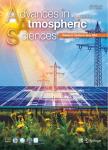A Fluid Experiment of Large-Scale Topography Effect on Baroclinic Wave Flows
A Fluid Experiment of Large-Scale Topography Effect on Baroclinic Wave Flows作者机构:Institute of Atmospheric Physics Academia Sinica Beijing China Geophysical Fluid Dynamics Institute Florida State UniversityTallahassee Florida U. S. A. Geophysical Fluid Dynamics Institute and Department of Meteorology Florida State University TallahasseeFlorida U. S. A.he effects of topography on baroclinic wave flows are studied experimentally in a thermally driven rotating annulus of fluid.Fourier analysis and complex principal component (CPC) analysis of the experimental data show that due to topographic forcing the flow is bimodal rather than a single mode. Under suitable imposed experimental parameters near thermal Rossby number ROT = 0.1 and Taylor number Ta = 2.2 × 107 the large-scale topography produces low-frequency oscillation in the flow and rather long-lived flow pattern resembling blocking in the atmospheric circulation. The 'blocking' phenomenon is caused by the resonance of travelling waves and the quasi-stationary waves forced by topography.The large-scale topography transforms wavenumber-homogeneous flows into wavenumber-dispersed flows and the dispersed flows possess lower wavenumbers.
出 版 物:《Advances in Atmospheric Sciences》 (大气科学进展(英文版))
年 卷 期:1992年第9卷第1期
页 面:17-28页
核心收录:
学科分类:07[理学] 070601[理学-气象学] 0706[理学-大气科学]
主 题:A Fluid Experiment of Large Scale Topography Effect on Baroclinic Wave Flows
摘 要:The effects of topography on baroclinic wave flows are studied experimentally in a thermally driven rotating annulus of *** analysis and complex principal component (CPC) analysis of the experimental data show that, due to topographic forcing, the flow is bimodal rather than a single mode. Under suitable imposed experimental parameters, near thermal Rossby number ROT = 0.1 and Taylor number Ta = 2.2 × 107, the large-scale topography produces low-frequency oscillation in the flow and rather long-lived flow pattern resembling blocking in the atmospheric circulation. The blocking phenomenon is caused by the resonance of travelling waves and the quasi-stationary waves forced by *** large-scale topography transforms wavenumber-homogeneous flows into wavenumber-dispersed flows, and the dispersed flows possess lower wavenumbers.



